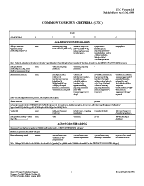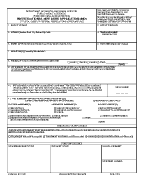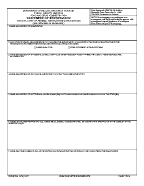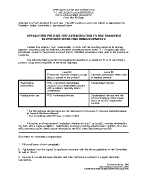|
The descriptions offered below are meant only as guidelines. Some tailoring will often be required to inform potential subjects adequately of deviations from the descriptions. For some procedures, alternative descriptions are offered.
ACTH Test
This test determines whether your adrenal gland is functioning normally. A catheter (a thin, flexible plastic tube) will be put into an arm vein. You will be asked to lie down and will be given an injection into a different arm vein. Periodic blood samples will be drawn from the catheter in your vein for the next 3 hours. You will be able to move around during the test.
Discomforts and risks: As with any vein puncture, it may be necessary to try more than once to insert the needle successfully, and you may get a hematoma ("black-and-blue" mark or lump). You may have some local pain at the needle site. There is a very small risk of infection.
Apheresis, Manual and Automated
The purpose of these 2-hour procedures is to treat certain conditions or to allow the investigator to obtain a larger number of white blood cells, red blood cells, or platelets for study than would be possible with usual blood-drawings. Similar procedures are used daily in blood banks to obtain blood products from healthy donors. Blood may be drawn on ____ occasions, but only from arm veins.
In manual apheresis, blood is drawn through a needle in the vein of one arm, into a plastic bag, and spun (centrifuged in a machine) to separate red blood cells from other blood components. The red blood cells are then returned to your body through the same needle.
In automated apheresis, blood is removed through a needle in the vein of one arm, continuously spun (centrifuged) in a machine that separates the desired component (usually white blood cells and plasma), and the remainder (mostly red blood cells) is returned continuously to the donor through a needle in a vein of the other arm (or through the same needle used to draw the blood).
Arterial (Radial) Catheterization
A catheter (a thin, flexible plastic tube) is inserted in one of the two arteries at your wrist. Before the catheter is inserted, we will make sure that both arteries are working. A small amount of a local anesthetic (numbing medicine) will be injected to numb the skin over the artery. Then, the catheter will be placed in the artery and fastened with tape. From this catheter we will take ___ samples, of ___ teaspoons each.
Discomforts and risks: Some discomfort is connected with placement of the arterial needle. Rarely, people faint. Even more rarely, the catheter gets infected. There is a remote chance that the artery might get blocked, but this has not been observed in several thousand of these procedures at NIH. Bruising or swelling at the site of the arterial catheter occurs in 5 percent to 20 percent of patients, but this is only temporary; permanent damage is extremely rare. We will watch for these risks and treat any problems that occur.
In the most extreme case, arterial blockage could cause loss of a hand or arm in patients with pre-existing severe disease of the artery. This complication has never been observed in individuals with normal circulation, and we will exclude those with abnormal circulation.
Biopsy, Liver
A needle is passed through the skin into the liver, beneath the right side of the lower ribcage, to obtain a small piece of tissue.
Discomforts and risks: About 20 percent of patients have some local pain lasting from a few minutes to several hours; this rarely requires medication and disappears within a day or two. In less than 1 case in 1,000, the biopsied liver bleeds severely, and blood transfusion or even surgery is needed; death has occurred from bleeding in less than 1 case in 10,000.
Biopsy, Muscle
The procedure is performed in the operating room. After a local anesthetic numbs the skin, an incision, 1/2 inch to 1 inch long, is made in the thigh (or upper arm), and a small piece of muscle is removed. The skin is closed with self-absorbing stitches. If the biopsy is done on your thigh, you may be asked to stay off your feet for 6 hours after the procedure.
Discomforts and risks: Discomfort during the procedure will be avoided by the use of a local anesthetic. The biopsy site may be tender for several days; this is usually controlled by medication. Risks include the rare complications of local bleeding or infection. A small scar will remain permanently at the biopsy site.
Biopsy, Nerve
The procedure is performed in the operating room. After a local anesthetic numbs the skin, an incision about 1 inch long will be made, usually just below the outside of the ankle or in mid-calf. A piece of nerve about 1 inch long will be removed. The skin will be closed with self-absorbing stitches.
Discomforts and risks: The biopsy site may be sore for a few days; this is usually controlled by aspirin-like pain medication. An area of numbness along the outside half of the heel, along the incision, or in the heel, occurs occasionally and usually subsides after 2 or 3 weeks but can persist for more than a year. Ankle swelling, treated by bedrest and elevation, occurs infrequently after biopsy. Risks include the rare complications of local infection or bleeding. A small scar will remain at the biopsy site.
Biopsy, Skin
The skin area to be biopsied is cleaned with iodine and alcohol. A local anesthetic numbs the area, and a 1/4-inch piece of skin is removed with a special tool.
Discomforts and risks: Pain at the biopsy site should be minimal; bleeding and infection are rare. Biopsy wounds usually heal with a very small, nearly unnoticeable scar, but sometimes a raised scar or visible lump may result. However, the biopsy will be taken from a place on your body that is not easily seen.
Blood Drawing (Venipuncture)
During this study, no more than ___ teaspoons (or ___ cups) of blood will be drawn. You may experience some discomfort at the site of needle entry, and there is a risk of a "black-and-blue" mark. There is a remote risk of fainting or local infection.
Bone Marrow Aspiration
The purpose of this procedure is to collect cells from your bone marrow. It will be done in the hospital/clinic and will take about 15 minutes. While you lie on your stomach, the skin over your hip bone will be cleaned with alcohol and iodine. A local anesthetic (numbing medicine) will be injected under the skin and into the outer covering of the bone. After the area is numb, a needle will be inserted into the bone. A syringe will be attached to this needle and a rapid suction movement (aspiration) will be made. The aspiration may be repeated several times so that an adequate number of bone marrow cells is obtained. There are no limitations on your activity after the procedure is over.
Discomforts and risks: You will feel mild burning for several seconds until the numbing begins. You will feel a pushing sensation, but no pain, as the needle enters the hip bone. As the marrow is aspirated, you may feel a sharp pain, lasting 1 to 2 seconds. There may be a small amount of residual pain, but within an hour or 2 you should feel normal. There is a remote risk of fainting during the procedure and of bleeding or local infection at the aspiration site.
Bronchoscopy
This procedure takes 30 to 90 minutes and involves passage of a long, narrow, flexible tube (bronchoscope) through the nose or mouth into the airways of the lung. Before passage of the tube, the nose and throat are sprayed with local anesthetic (numbing medicine). When the bronchoscope has been steered into a specific airway of the lung, a small amount of sterile water may be squirted through it into the lung and immediately suctioned back, washing off some of the cells lining the airways. The fluid and cells are then analyzed in the laboratory.
Discomforts and risks: There is no known risk of this procedure in individuals with normal hearts and lungs, but as a precaution we will monitor heart rhythm and rate, and place a small needle in an arm vein. There may be some discomfort when the bronchoscope is passed through the nose, and occasional patients experience gagging and an urge to cough when the bronchoscope is passing through the throat and the vocal cords. A sore throat and mild hoarseness may persist for several hours; these resolve routinely within a day. Occasionally, subjects have temporary fever following bronchoscopy; in hundreds of studies carried out to date by the Pulmonary Branch, such fevers have gone away promptly and have required no therapy other than an aspirin-like medication.
Computerized Axial Tomography (CAT or CT) Scan
A CAT (computerized axial tomography) scan requires that you lie still for a short time while x-ray images are formed. It may also require an injection of dye through a needle placed in an arm vein.
Colonoscopy
A flexible instrument with a special system of lighting (colonoscope) permits your doctor to examine the large intestine. Before the procedure, an intravenous sedative will be given to relax you. Then a flexible tube will be inserted into your rectum and advanced. The procedure takes 20 to 90 minutes. Your doctor may want to biopsy (cut out a small piece for diagnosis) suspicious areas.
Discomforts and risks: The IV sedative may slow or, very rarely, stop breathing, but this can be reversed by other medications. Patients who have abnormal or replaced heart valves, pacemakers, artificial joints, or vascular surgery grafts are at risk for infection; antibiotics may be administered before and after the procedure. The risk of perforation of the colon is 2 to 4 in 1,000 cases, with possible bleeding or infection that might require a blood transfusion, antibiotics, or surgery. Rarely, irregular heart beats and ruptures of the spleen have occurred. Death has followed the procedure in approximately 1 of 10,000 studies.
Electrocardiogram (EKG, ECG)
A recording of the normal electrical activity of your heart is taken by placing electrodes (pieces of metal attached to wires) on the skin of your chest, arms, and legs. There is no discomfort and there are no risks.
Electroencephalogram (EEG)
A recording of the normal electrical activity (waves) of your brain is taken by securing electrodes to your scalp with a glue-like substance (collodion), that can be removed with a substance similar to nail polish remover (acetone). We will measure your brain waves while you are lying quietly, breathing deeply (hyperventilating), watching bright flashes of light (photic stimulating), or sleeping. The session will last for 1 to 2 hours.
Discomforts and risks: Both the glue and the remover acetone have strong odors but do not have any harmful effects when used for a short time.
Electromyography/Nerve Conduction Study (EMG/NCS)
Electromyography (EMG) measures the electrical activity of muscles. It involves insertion of a needle into a muscle to record its electrical activity. You may experience pain at the site of needle entry. Hazards include the slight possibility of infection or bleeding.
Nerve conduction studies measure the speed with which nerves conduct electrical impulses. These studies are performed by taping a wire on the skin to record the impulses and another wire on the skin over the nerve to deliver a small electrical stimulus. You might experience discomfort during the nerve stimulation. If this is too uncomfortable, you can stop the test.
These two studies usually are performed during the same session and take from 1/2 to 1 hour.
Endoscopy, Upper Gastrointestinal
This procedure takes less than 30 minutes and involves the passage of a long, flexible tube (endoscope) through the esophagus (swallowing tube), stomach, and duodenum (small intestine). Your throat will be sprayed beforehand with a local anesthetic (numbing medicine), and an intravenous medication will be given to relax you.
Discomforts and risks: Patients sometimes experience a sore throat, gagging, nausea, or bloating. The overall complication rate for upper gastrointestinal endoscopy is slightly more than 1 in 1,000 cases. These include bleeding (about 3 in 10,000 cases), aspiration (inhalation) of stomach contents into the lungs, abnormal heart rhythms, or lower-than-normal breathing rates (approximately 6 in 10,000), and puncture of the wall of the esophagus (3 in 10,000) cases. There is an extremely small risk of puncturing the wall of the stomach or intestine. Puncture of any of these organs could be followed by bleeding or infection that might require blood transfusion, antibiotics, or surgery. Death followed the procedure in 7 of 10,000 cases.
Evoked Potentials
These tests are similar to the electroencephalogram (EEG) and last 1 to 2 hours. During the study of somatosensory evoked potentials (SEP), nerves in the arms and legs are stimulated electrically. During the visual evoked potentials (VEP) study, you will be requested to watch black-and-white checks moving on a TV screen. During the study of brainstem auditory evoked potentials (BAEP), you will be asked to wear headphones and will hear several clicking sounds of different pitches; each ear will be tested separately. In each study, responses are recorded from electrodes (pieces of metal attached to wires) placed on the scalp, neck, and back.
Discomforts and risks: Similar to those of EEG recording. Electrical stimulation of nerves may cause some stinging sensation.
Glucagon Test
This test determines whether your liver releases glucose (sugar) normally. A catheter is put into an arm vein, and the hormone glucagon is injected into an arm muscle (or another arm vein). Blood is drawn periodically, as you lie quietly for the next 3 hours.
Discomforts and risks: You will have some local pain at the needle sites. Glucagon causes nausea and occasionally vomiting in some people.
Lumbar Puncture (Spinal Tap)
The lumbar puncture (LP) or spinal tap lets us study cerebrospinal fluid (CSF) to learn some of what is going on in the brain and spinal cord, which are bathed by CSF.
You will lie on your side, and a local anesthetic will be used to numb an area in your lower back. Then, about 2 tablespoons of spinal fluid will be collected.
Discomforts and risks: Some patients may develop a headache or backache following an LP. Prolonged headaches develop in only 1 in 50 to 1 in 200 subjects and usually subside within 1 week. The likelihood of having a headache may be diminished by lying flat in bed for 24 hours after the LP.
In rare cases, post-LP headaches persist for months or years. Such headaches may result from continued CSF leakage at the LP site. If the headache lasts longer than 1 week, a "blood patch" can be done. A small amount of blood from your arm vein is injected into the area of the supposed leak to try to seal it. The blood patch relieves the headache in most (95 percent in some studies) patients.
Magnetic Resonance Imaging (MRI)
Magnetic resonance imaging (MRI) uses a strong magnetic field and radio waves to demonstrate structural and chemical changes in tissue. This technique is more sensitive than x-ray in some diseases and carries no radiation risk. You will lie on a table in a space enclosed by a metal cylinder (the scanner itself). The time required to stay within the cylinder will be about ___ minutes/hours. You will be asked to lie very still for 10 to 15 minutes at a time.
Discomforts and risks: Patients are at risk for injury from MRI if they have metal objects in their bodies, such as pacemakers, aneurysm clips (metal clips on the wall of a large artery), metallic prostheses, cochlear implants, or shrapnel fragments. Welders and metal workers are also at risk for eye injury because of unsuspected tiny metal fragments there.
Individuals with fear of confined spaces may become anxious during MRI. You will hear a thumping noise created by the radio waves forming the images. You will feel no pain, but you may find the noise and the closed-in space discomforting. You will be observed at all times by the operators and will be able to speak to them; you can be moved out of the machine at your request.
Nerve Conduction Study
See Electromyography/Nerve Conduction Study.
Oral Glucose Tolerance Test
This is the routine test used for many years to diagnose diabetes. A needle with small, flexible plastic tubing (catheter) is placed in an arm vein to withdraw about a teaspoon of blood before you drink a sugar solution, and at 30 minutes, 1 hour, 2 hours, and 3 hours afterwards.
Discomforts and risks: Some people experience nausea after drinking the sugar solution. Rarely, a bruise or minor infection may occur where the catheter needle entered your vein.
Upper Gastrointestinal Endoscopy
See Endoscopy, Upper Gastrointestinal.
Venipuncture
See Blood Drawing. |






